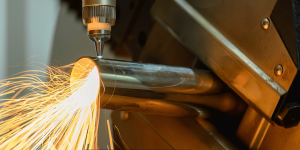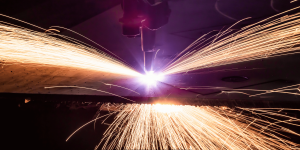CNC -plasma snijden is een techniek die een plasmaka gebruikt die wordt bestuurd door een CNC -machine om onderdelen uit plaatmetaal te snijden. Handmatig plasma snijden is langzaam en de gesneden sneden zijn niet erg netjes, maar met behulp van dit gereedschap, Het snijden is elegant en wordt in een kortere tijd gedaan.
Hier is een overzicht van hoe CNC -plasma snijden werkt en klaar is:
Inzicht in plasma snijden
Voordat u verder gaat in het uitleggen van CNC -plasma -snijden, Het is essentieel om uit te leggen waar het plasma snijden om draait. Plasma-snijden gebruikt een gecomprimeerd gas dat door een klein mondstuk in de plasmakache is uitgeworpen om een energierijke plasma-boog te maken; Deze plasmastroom kan gemakkelijk door metaal snijden.
Het plasma is heet genoeg om het metaal te smelten dat wordt gesneden tijdens het snijproces. Vervolgens, Een stroom gecomprimeerde lucht blaast het gesmolten metaal opzij, waardoor een gladde en rechte snit achterblijft. Plasma kan door staal snijden, aluminium, Koper en andere metalen die gemakkelijk en met gemak en met een hoog niveau van precisie zijn.
Wat is een CNC -plasma -snijder?
A CNC plasmamachine Bestaat uit een plasmaka op een mechanische structuur die het portaalsysteem wordt genoemd. Het maakt gebruik van een plasmaka om op het werkstuk in de x te handelen, Y & Z Richtingen volgens de CNC -opdrachten van de ingebouwde machinecontroller.

Met CNC kan plasma -snijder herhaaldelijk door metaal snijden en met een nauwkeurigheid van maximaal +/- 0. 001 inch. Het kan gemakkelijk worden geprogrammeerd om nauwkeurige sneden op complexe vormen te maken bij hogere snelheden. De operator is alleen nodig om de nodige vormen in de software in te voeren of over te dragen.
Stappen in CNC -plasma snijden
Hier zijn de basisstappen om CNC -plasma te snijden:
Ontwerp de onderdelen
De eerste stap is het schetsen van de vormen en onderdelen die u op de computer wilt knippen met behulp van een CAD -tool. Converteer de CAD -ontwerpen of CAD -tekeningen in formaten die acceptabel zijn door CNC Plasma Machine -software. De meest voorkomende formaten zijn DXF en DWG.
Bereid de machine voor
Er zijn specifieke voorbereidingen op de machine die moeten worden getroffen voordat deze kan worden gebruikt om te snijden. Schrob alle slakken, vuil, en olie van eerdere sneden met een borstel en alcohol/aceton. Zorg ervoor dat de juiste fakkelverbruiksgoederen zijn gemonteerd. Niveau de snijtafel. Tank de gecomprimeerde luchttank en het koelsysteem bij. Breng het metalen werkstuk op de juiste manier naar de machine.
Input CNC -programma
Kopieer uw CAD -snijpatronen naar de CNC -software. Repareer de juiste afmetingen en coördinaten. Het is belangrijk om ook de gesneden reeks op te geven bij het knippen van verschillende onderdelen. Voer meer CNC -codes in voor de snijinstelling zoals snijsnelheid, plasmastroom, stand -off hoogte, Pierce vertraging enz. Controleer de juiste paden die zijn geprogrammeerd.
Testsneden uitvoeren
Het wordt aanbevolen dat een test wordt gemaakt op een stuk van hetzelfde metaal voordat de werkelijke sneden worden gebruikt om in de productie te worden gebruikt. Dit helpt bij het instellen van de juiste instellingen. Bekijk het teststuk en wijzig dergelijke parameters als plasmastroom, snijsnelheid, enzovoort., indien nodig, Voordat de productie wordt uitgevoerd.
Begin met snijden
Als u klaar bent om te beginnen, begin de werking van de CNC -snijcyclus. De machine vertaalt eerst de plasmastakel naar het geprogrammeerde pierce -punt van het te snijden staal. De hoogspanningsvonk zal worden gebruikt om de perslucht te ioniseren en bijgevolg, Maak de plasma -boog die door het metaal zal smelten en het ontworpen snijpad volgt. Deze gecomprimeerde lucht blaast de gesmolten slak weg van de snede. Zoals gecontroleerd door het programma, Deze machine snijdt alle onderdelen die zijn geprogrammeerd om te worden gesneden.

Onderdeelverwijdering & Opruimen
Zodra het snijden voorbij is, De gesneden delen moeten uit het werkstuk worden verwijderd of met de hand of met behulp van de deel extractiehaken. Schraap eventuele resterende slak of bramen met slijpen of schuurapparatuur. De onderdelen zijn nu klaar voor verdere afwerking of voor gebruik zoals ze zijn.
Voordelen van CNC -plasma snijden
Vergeleken met handmatig plasma -snijden, CNC Plasma biedt de volgende voordelen:
– Een hoger niveau van snijnauwkeurigheid en snijvoordelen
– Het is in staat om zowel krommen als hoeken te maken, evenals gaten.
– Omdat het snijdenproces onder automatisering komt, Het resulteert in een veel snellere snijtijd in vergelijking met handmatig snijden.
– Gestandaardiseerde componenten in grote hoeveelheden
– Aanzienlijke afname van de waarschijnlijkheid om fouten en vermoeidheid te maken bij de operators
– Verbeterde efficiëntie en winstgevendheid
– Handig om te gebruiken wanneer tijdens het productie van veel vergelijkbare componenten.
Het is gemakkelijk, efficiënt, en veel consistenter om gesneden metalen onderdelen van hoge kwaliteit te krijgen zodra het plasmasnijproces is geautomatiseerd met behulp van CNC. Het opent ook de mogelijkheid om gedetailleerde ontwerpen te maken met het plasma, iets wat voorheen niet mogelijk was. CNC-plasmasnijmachine is een van de beste machines die een fabricagewinkel kan bezitten.
